Punctuation & Syllabication
> Smberdaxagar
Syllabication
Exercises , lesson plans & rubrics.
Period , Full Stop , Question Mark and Exclamation Mark.
‽, ¶ , &,@,§,#,*,‡, †
Capitalization. Quotation Marks and Ellipses. Brackets, Braces and Parentheses. Dash, Slash ,Underscore & Hyphen. Comma, Colon & Semicolon.
Apostrophe. Punctuation Explained (by Punctuation!)
English Punctuation. In this post, you can learn the words used for English punctuation.
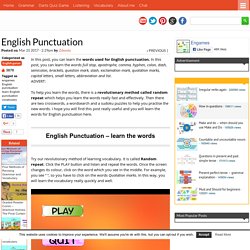
In this post, you can learn the words full stop, apostrophe, comma, hyphen, colon, dash, semicolon, brackets, question mark, slash, exclamation mark, quotation marks, capital letters, small letters, abbreviation and list. ADVERT: To help you learn the words, there is a revolutionary method called random repeat which helps you learn the words really fast and effectively. Then there are two crosswords, a wordsearch and a sudoku puzzles to help you practise the new words.
I hope you will find this post really useful and you will learn the words for English punctuation here. English Punctuation – learn the words Try our revolutionary method of learning vocabulary. If you need some examples of the usage, look here: He/She can’t make it. slash, apostrophe, full stopCheers! If you prefer graphical presentation of new vocabulary, try the following infographic.
Punctuation Marks in English – Rules and Examples. Rules and Examples Punctuation marks are an important part of English grammar and writing.
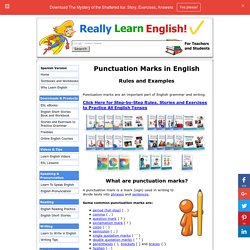
Click Here for Step-by-Step Rules, Stories and Exercises to Practice All English Tenses. Signs and symbols: the names of punctuation marks. Chances are that you use them every day – from ‘ to # and ?
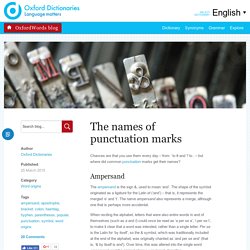
To . – but where did common punctuation marks get their names? Ampersand The ampersand is the sign &, used to mean ‘and’. The shape of the symbol originated as a ligature for the Latin et (‘and’) – that is, it represents the merged ‘e’ and ‘t’. The name ampersand also represents a merge, although one that is perhaps more accidental. When reciting the alphabet, letters that were also entire words in and of themselves (such as a and I) could once be read as ‘a per se a’, ‘i per se I’, to make it clear that a word was intended, rather than a single letter.
Proofreading and editing tips. General tips for proofing Read it out loud and also silently.
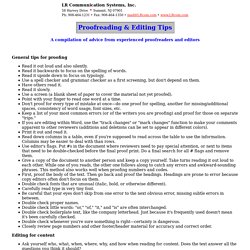
Read it backwards to focus on the spelling of words. Read it upside down to focus on typology. Use a spell checker and grammar checker as a first screening, but don't depend on them. Have others read it. Read it slowly.
Super Teacher Worksheets - Thousands of Printable Activities. Proofreading Symbols and Abbreviations. Common Proofreading Symbols Common Proofreading Abbreviations (The abbreviation would appear in the margin, probably with a line or arrow pointing to the offending element.)
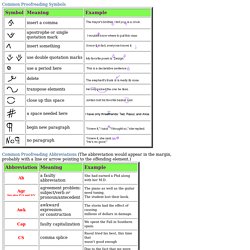
Some Online Aids on Proofreading and Editing Editing and Rewriting (from the Guide to Grammar and Writing) "Revising Your Writing" from Paradigm "Editing Your Writing" from Paradigm. 13 Little-Known Punctuation Marks We Should Be Using. Because sometimes periods, commas, colons, semi-colons, dashes, hyphens, apostrophes, question marks, exclamation points, quotation marks, brackets, parentheses, braces, and ellipses won't do. 1.
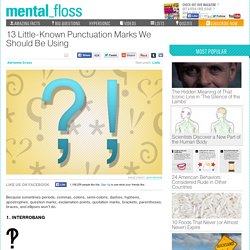
Interrobang You probably already know the interrobang, thanks to its excellent moniker and increasing popularity.
The-69-rules-of-punctuation-infographic.jpg (JPEG Image, 2550 × 1650 pixels) - Scaled (40%)
Culture - The mysterious origins of punctuation. As readers and writers, we’re intimately familiar with the dots, strokes and dashes that punctuate the written word.
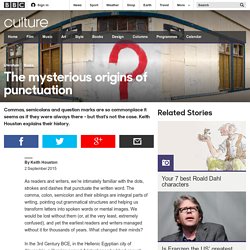
The comma, colon, semicolon and their siblings are integral parts of writing, pointing out grammatical structures and helping us transform letters into spoken words or mental images. We would be lost without them (or, at the very least, extremely confused), and yet the earliest readers and writers managed without it for thousands of years. What changed their minds? In the 3rd Century BCE, in the Hellenic Egyptian city of Alexandria, a librarian named Aristophanes had had enough. He was chief of staff at the city’s famous library, home to hundreds of thousands of scrolls, which were all frustratingly time-consuming to read.
The Punctuation Song. Punctuation. The sentence and the full stop The full stop is the most important punctuation mark.
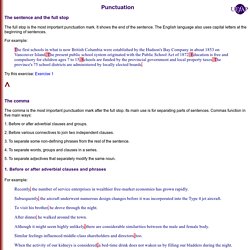
It shows the end of the sentence. The English language also uses capital letters at the beginning of sentences. For example: The first schools in what is now British Columbia were established by the Hudson's Bay Company in about 1853 on Vancouver Island.
The Sentence Song ♫♪♫
What Are the Fourteen Punctuation Marks in English Grammar?
There are fourteen punctuation marks commonly used in English grammar.

They are the period, question mark, exclamation point, comma, semicolon, colon, dash, hyphen, parentheses, brackets, braces, apostrophe, quotation marks, and ellipsis. Sentence Endings Three of the fourteen punctuation marks are appropriate for use as sentence endings. They are the period, question mark, and exclamation point. The period (.) is placed at the end of declarative sentences, statements thought to be complete and after many abbreviations. As a sentence ender: Jane and Jack went to the market. Use a question mark (?) When did Jane leave for the market? The exclamation point (!)
Pin de Larry Ferlazzo en Useful Classroom Images. Recognising punctuation. Sentence Level: Basic Punctuation. Punctuation Self-Test. Punctuation.
Think you know your stuff?

CLICK HERE to quiz yourself. Like grammar nerds like to say, punctuation is a matter of life and death. There's a huge difference between "Let's eat, Grandma" and "Let's eat Grandma.
" Ba-dum ching! Yes, grammarians can also be cornballs. In some canonized examples (Buzzfeed is part of the canon now, right?) You could write that, "Rachel Ray finds inspiration in cooking her family and her dog.
" You could post a sign in the disabled/family restroom at your establishment that reads "Attention: toilet only for disabled elderly pregnant children.
"
Punctuating dialogue - www.fiction-writers-mentor.com. Punctuating dialogue is an essential skill, but it can be quite confusing. Here's my handy guide to it. I've tried to make a complex subject as clear and easy as possible. In novels and short stories all dialogue goes between inverted commas (U.S: quotes). These are double inverted commas/quotes: “…”. We do use single inverted commas/quotes (‘…’) too, and I’ll come to those below. So, a dialogue sentence would be written like these examples: “Don’t drop it!”
Modify - A tool for teachers that removes punctuation and inserts incorrect homonyms and homophones and misspellings into added text.
Mentor Text: Conventions of Writng - Punctuation. Loading... Mentor Text: Conventions of Writng - Punctuation Objective: SWBAT use standard conventions of writing, specifically punctuation marks. Dr. Miranti Murphy 148 Lessons. Pinterest. Punctuate Me - Super Heroes - Complex Speech. Punctuation, English Games for 7-11 Years. Punctuation. Practising punctuation. Transcription Techniques for the Spoken Word - Willow Roberts Powers - Google Books.
5 Reading Comprehension Strategies. Home › Reading › Lessons › Comprehension Actively teaching reading comprehension strategies is a not an easy task. These five activities take students deeper into Bloom's Taxonomy as part of a balanced literacy program. These activities also support teaching fluency in reading. Fluency isn't just about being able to sound out the words: it is about prosody and comprehension too. The lessons can be taught at any grade level, although you will have to differentiate them to meet your standards. Here are five more activities to add to your toolbox . Written Response Allowing children to generate authentic, meaningful responses to literature is one of the most powerful reading comprehension activities. Write About Your Favorite Part: This is the simplest type of response for beginning readers and those who struggle with comprehension.Text to Self Connection: Has anything like this ever happened to you?
Punctuation. Language is either to be heard or to be seen; it is either oral or visual. Actually, in our society it is both. We hear spoken language; we see written language. But human communication is not so simple. We also hear inside our heads what it is we read. What we hear also inside our heads also influences what we see, what we write.
Oral Storytelling (Capitals and Punctuation)
KS2 Bitesize English - Punctuation : Fullscreen. Notice all punctuation while reading - for students. Analyze how a poet's use of punctuation develops the theme - for students. OER Commons. Punctuation, Literacy, Key Stage 2 - Interactive Whiteboard Resources.
Sentence Detectives A useful site for teaching basic punctuation marks such as question marks, exclamation marks and full stops. Includes a download option. Types of Sentence An interactive activity with the character Ed the owl. The site looks at different types of sentences and the punctuation that needed to go with them.
Editing a written response for spelling and punctuation - for students.
Punctuation is Important. Read dialogue using punctuation as a guide - for students. Instant Grammar Check - Plagiarism Checker - Online Proofreader. Gregory's Writing Site. Grammar Exercises. Acting Out Punctuation in HD - 95 Percent Group Inc.
Literacy Activities and English Games. Punctuation Game for Kids - Fun Grammar Practice Exercise Activity.
Solving the punctuation puzzle by Dictionary.com. Slideshow. National Punctuation Day. The Punctuation Guide. Signs For Copy Editing, Grammar, Punctuation & More - Enago™
Pinterest. Symbols and Advanced Punctuation. Punctuation Explained (by Punctuation!)
English for Everybody. Advanced Course: Punctuation.
What is punctuation? Punctuation is the use of non-alphabetical symbols in writing in order to make the text clearer or easier to read.
Top 10 Tips How to Punctuate Speech and Dialogue - Proof Edit Write. Punctuation. The 15 Punctuation Marks in Order of Difficulty. Ever wonder why you can’t figure out when and where to stick a comma?
What Is the Punctuation Pyramid? (with picture)
Punctuating Dialogue by MissLunaRose on DeviantArt. Top 10 Rules of Punctuation. The Arts. Introduction to the Basic Rules of Punctuation.
British versus American style. There are two major styles of English punctuation: American (commonly followed also in Canada) and British (commonly followed also in Australia and New Zealand). Over the years, these two styles have converged.
Capitalisation rules. Capital letters are used with particular types of nouns, in certain positions in sentences, and with some adjectives. You must always use capital letters for:
Top 10 Authors Who Ignored The Basic Rules of Punctuation. By May Huang. What is Proofreading? - Definition, Symbols & Quiz.
Proofreading is the process of looking for and correcting errors in your work. Learn how to proofread accurately and effectively before submitting anything you write.
British versus American style. The Seven Deadly Sins of Punctuation. While there are countless ways to ruin good writing, there is probably no quicker way to lose writing credibility than by exhibiting punctuation errors.
Infographic: Lesser known punctuation marks. Writing with Sharon Watson-Easy-to-use Homeschool Writing Curriculum. Punctuation Information On Level Intermediate Age 14 17 Pictures. How to Use English Punctuation Correctly (with Examples)
Punctuation. Basic Punctuation Rules and Help. Punctuation Marks.










